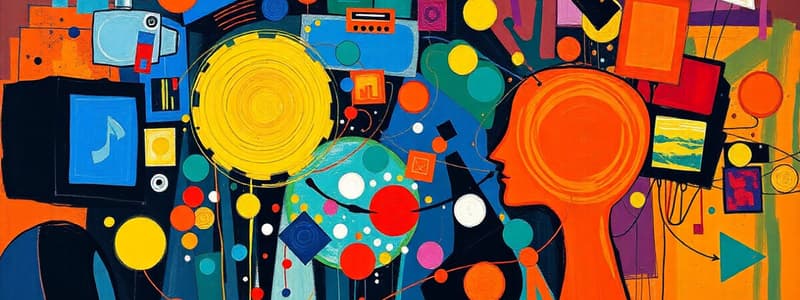Podcast
Questions and Answers
What is the primary purpose of media richness theory?
What is the primary purpose of media richness theory?
- To describe and evaluate the richness of communication mediums (correct)
- To rank social media platforms by popularity
- To enhance the clarity of all communication mediums
- To identify the most efficient communication methods
According to media richness theory, which of the following communication mediums is considered the richest?
According to media richness theory, which of the following communication mediums is considered the richest?
- Phone calls
- Video conferencing (correct)
- Text messaging
What communication challenge is media richness theory primarily designed to address?
What communication challenge is media richness theory primarily designed to address?
- Unclear or confusing messages (correct)
- The cost of communication tools
- Data privacy concerns in communication
- Technical issues in communication software
What should senders consider when choosing a communication medium according to media richness theory?
What should senders consider when choosing a communication medium according to media richness theory?
Which aspect is NOT a limitation of using less-rich communication media?
Which aspect is NOT a limitation of using less-rich communication media?
Explain how media richness theory can influence managerial communication decisions.
Explain how media richness theory can influence managerial communication decisions.
What are the key dimensions that media richness theory evaluates in communication mediums?
What are the key dimensions that media richness theory evaluates in communication mediums?
Discuss a scenario where using a less-rich communication medium could lead to misunderstandings.
Discuss a scenario where using a less-rich communication medium could lead to misunderstandings.
How does media richness theory relate to information processing theory?
How does media richness theory relate to information processing theory?
Describe a limitation of relying solely on richer communication mediums.
Describe a limitation of relying solely on richer communication mediums.
Flashcards are hidden until you start studying
Study Notes
Media Richness Theory
- Developed by Richard L. Daft and Robert H. Lengel
- Focuses on the ability of communication mediums to reproduce information, ranking their richness.
- Examples of mediums: phone calls, video conferencing, and email.
- Aims to address communication challenges in organizations such as unclear messages or misinterpretations.
Application
- Senders should use the richest medium possible to communicate the desired message.
- Senders using less rich mediums must understand their limitations:
- Feedback
- Multiple cues
- Message tailoring
- Emotions
- Example: Determining the tone of a text message.
Media Richness Theory
- Media richness theory describes the ability of a communication medium to reproduce information
- Richard L. Daft and Robert H. Lengel developed the theory in 1984
- The theory is used to rank and evaluate communication mediums like phone calls, video conferencing, and email
- The goal of this theory is to help organizations cope with communication challenges like unclear or confusing messages
Application
- The theory helps senders choose the communication medium that best suits their message
- The theory suggests using the richest possible medium for communication
- Senders using less-rich media should understand the limitations of that medium (e.g., feedback, multiple cues, message tailoring, and emotions)
- For example, it's difficult to determine tone in a text message because it lacks richness
Studying That Suits You
Use AI to generate personalized quizzes and flashcards to suit your learning preferences.




